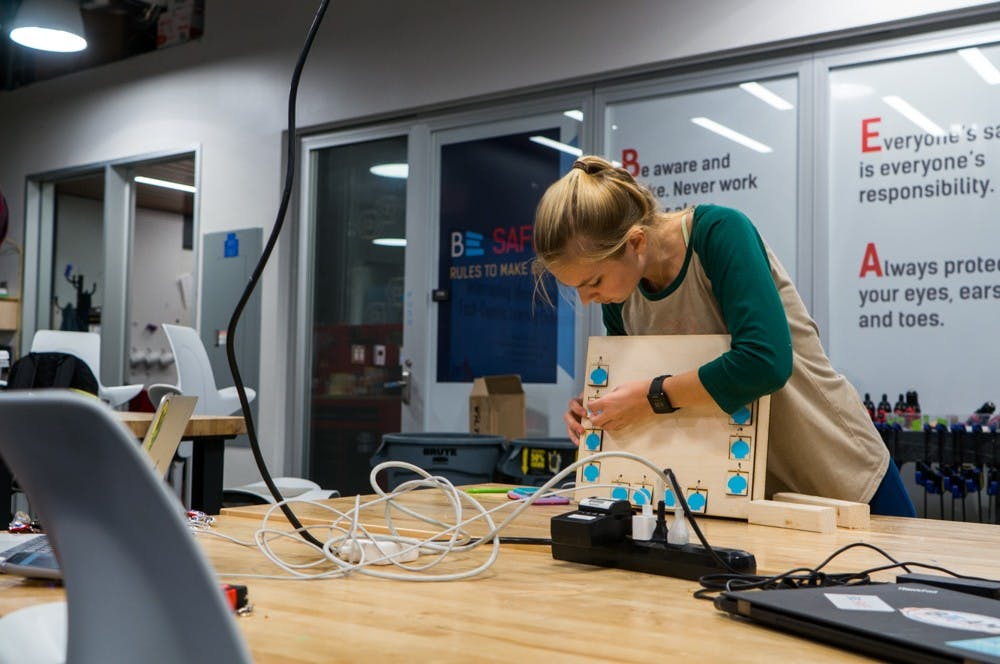Before creating, students must attend specific trainings for the resource they desire to use. After being trained, students are then able to expand their capabilities and push themselves to create said Drew Robertson, Murray Hall makerspace manager.
“A lot of people who haven’t been in our spaces yet, they have an assumption, and that is that we are STEM concentrated,” Robertson said. “While we love and encourage research, what a lot of people don’t realize is that in one way research means just learning the capabilities of all sorts of things. That might be artistic research and learning how to push yourself.”
Artistic creations
Many students come in and conduct artistic research, both for classes and for personal projects.
“One student is a documentary film studies student, I believe, and they’re making a clothing line with the embroidery machine, embroidering words and art on their clothing line that they’re shooting a documentary on,” Herrera said. “I think that’s a really, really impressive project; he’s been working so hard.”
The sewing and embroidery machines are quite popular for creating art, especially during Halloween, as many students don’t have these machines in their rooms, Robertson said.
“One of my favorite artistic endeavors I see our spaces used for each year are just some of the amazing costumes that are made in our spaces,” Robertson said. “They’re using our sewing machines, embroidery machines, but they’re also using other things in creative ways, like 3D printing props for their costumes.”
Other students have chosen to create using less traditional methods, such as using PVC pipes, Herrera said.
“A student is in here pretty frequently working on a Slovakian traditional wind instrument,” Herrera said. “He’s creating this instrument out of PVC pipes and you can hear him testing the pitch, making sure it’s working, creating new pieces of it so he can have this traditional instrument made out of stuff here in the makerspace.”
Many classes, including ones within the fine arts, use the makerspaces for their projects, and last year almost 300 classes were involved with the spaces, Robertson said.
“We had a class where each person in the class laser cut the pieces and made pinhole cameras,” Robertson said. “Just seeing some of the pictures that were taken with the pinhole cameras were really cool.”
Fedor, who is involved with the Hanes Art Center makerspace, commonly sees art students and people interested in art in the space working on projects.
To get the day's news and headlines in your inbox each morning, sign up for our email newsletters.
“I was working with a student this morning that is building a stage prop for the opera,” Fedor said. “Last year, we had an entire class come down and create the canvases that they did their artwork on.”
Intimidation is a big reason students don’t enter the space, but coming to something as simple as the orientation training can lead to great success, Robertson said.
“When you realize how you can actually just draw something, and it doesn’t have to be perfect, but you just sketch something out and then use those tools to bring it to life, people really take a sense of pride in that and they start to actually want to make something bigger or try a different challenge,” Robertson said.
Great art can come out of the makerspaces, but it’s impossible to create it if people never enter the spaces and test out the machines, Fedor said.
“I encourage people to — and I use this term a lot — I say come in a play with the machines,” Fedor said. “If you walk away from the training having touched all of the machines, you then have a basis to say ‘I either really like this, or I really don’t.’ Everything is built one step at a time, and you can come in here and it just unlocks this whole new world of seeing how things are built.”
@Sarah_campbs
arts@dailytarheel.com




